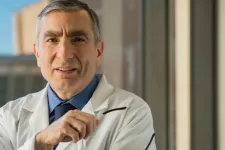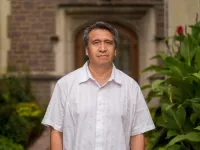SNIS 2024: New study shows critical improvements in treating rare eye cancer in children
2024-07-25
(Press-News.org) FOR IMMEDIATE RELEASE: July 24, 2024, 3:20 P.M. MDT
CONTACT: Camille Jewell
cjewell@vancomm.com or 202-248-5460
COLORADO SPRINGS, Colo. — The evolution of retinoblastoma treatment over the past 15 years has resulted in a higher likelihood of vision preservation without compromising survival, according to research released today at the Society of NeuroInterventional Surgery’s (SNIS) 21st Annual Meeting.
Retinoblastoma, a rare eye cancer that affects young children, carries a risk of impaired vision and removal of one or both eyes. It is fatal if left untreated.
The study, “Advancement in Super-Selective Catheterization and Drug Selection for Intra-Arterial Chemotherapy for Retinoblastoma: A 15-year Evolution,” reviewed how children received intra-arterial chemotherapy (IAC), the gold standard for treating retinoblastoma, by delivering chemotherapy directly to the affected eye. Using IAC helps to minimize the need to remove a patient’s affected eye and maximizes their ability to see after treatment, as well as their potential to survive the cancer.
The research team — composed of neurointerventionalists from New York-Presbyterian Hospital/Weill Cornell Medicine, and ophthalmologic oncologists at Memorial Sloan Kettering Cancer Center — reviewed medical records for 571 patients separated into three cohorts five years apart. The data was evaluated to determine how routes of vascular access to the ophthalmic artery has evolved over time, how many patients have had complications from the procedure, and what combinations of chemotherapy drugs patients have received. Researchers found that, of a total of 2,402 attempted IAC sessions, 2,391 (99.5%) were successful. Success rates of super-selective catheterizations, where the ophthalmic artery was catheterized directly, also has improved over time; 80% of the earliest procedures were successful compared to 89.2% of the most recent procedures.
Procedure complication rates stayed very low over time at 0.7% for the earliest cohort, 1.1% in the middle cohort and 0.6% in the most recent cohort. In addition, researchers found that more and more children have successfully received a three-chemotherapy combination from 21% of the earliest cohort to 66.7% of the most recent cohort. Finally, the authors proposed a stepwise algorithm to help others maximize direct vascular access to the ophthalmic artery.
“We are proud to share our history of ongoing success in using this minimally invasive method to care for some of our youngest cancer patients,” said Gary Kocharian, MD, Neurosurgery Chief Resident and Endovascular Neurosurgery Fellow at New York-Presbyterian Hospital.
“Giving children the opportunity to both keep their eyesight and beat this disease is life-changing for families across the world. We look forward to seeing what innovations are made in the next 15 years,” said Y. Pierre Gobin, MD, one of the earliest pioneers of this revolutionary procedure.
To receive a copy of this abstract or to speak with the study authors, please contact Camille Jewell at cjewell@vancomm.com or call 202-248-5460.
About the Society of NeuroInterventional Surgery
The Society of NeuroInterventional Surgery (SNIS) is a scientific and educational association dedicated to advancing the specialty of neurointerventional surgery through research, standard-setting, and education and advocacy to provide the highest quality of patient care in diagnosing and treating diseases of the brain, spine, head, and neck. Visit www.snisonline.org and follow us on X (@SNISinfo) and Facebook (@SNISOnline).
###
END
ELSE PRESS RELEASES FROM THIS DATE:
2024-07-24
Using a wearable device, such as a smart watch, to track health data and symptoms, is supposed to help people monitor their health and address symptoms as quickly as possible to spur positive health outcomes. But for people with atrial fibrillation, also known as Afib, using a wearable device to monitor the heart rate and to alert wearers of an irregular heartbeat might not be as helpful as wearers think.
A new study in the Journal of the American Heart Association, led by Lindsay Rosman, PhD, assistant professor of medicine in the ...
2024-07-24
Dr. Olga Denysiuk, MD, PhD, is a highly skilled eye surgeon in Ukraine who now finds herself at the frontlines of ophthalmic trauma care caused by war.
“Every day, I am fighting my war in the operating room,” says Denysiuk. “Cases of eye trauma are mounting and it’s critical that we have surgeons trained to delicately manage eyelid and orbital injuries.”
Denysiuk is one of two ocular specialists selected for a unique humanitarian fellowship at the University of Calgary’s ...
2024-07-24
A research team at Rice University led by James Tour, the T.T. and W.F. Chao Professor of Chemistry and professor of materials science and nanoengineering, is tackling the environmental issue of efficiently recycling lithium ion batteries amid their increasing use.
The team has pioneered a new method to extract purified active materials from battery waste as detailed in the journal Nature Communications on July 24. Their findings have the potential to facilitate the effective separation and recycling of valuable battery materials ...
2024-07-24
Self-driving cars occasionally crash because their visual systems can’t always process static or slow-moving objects in 3D space. In that regard, they’re like the monocular vision of many insects, whose compound eyes provide great motion-tracking and a wide field of view but poor depth perception.
Except for the praying mantis.
A praying mantis’ field of view also overlaps between its left and right eyes, creating binocular vision with depth perception in 3D space.
Combining this insight with some nifty optoelectrical engineering and innovative “edge” ...
2024-07-24
New research led by UCLA Health has found that specific genes may be related to the trajectory of recovery for stroke survivors, providing doctors insights useful for developing targeted therapies.
Published in the journal Stroke this month, the findings were part of an exploratory study that sought to find if candidate genes could predict a higher likelihood of stroke outcomes related to depression, post-traumatic stress disorder and cognitive decline.
Dr. Steven C. Cramer, MD, the study’s lead author and a professor of neurology at UCLA, said while there are some ...
2024-07-24
HOUSTON – (July 24, 2024) – When picturing next-generation wearables and robotics, the foam filling in your couch cushions is likely not the first thing that comes to mind.
However, Rice University engineers have shown that something as simple as the flow of air through the airy, meshlike structure of open-cell foam can be used to perform digital computation, analog sensing and combined digital-analog control in soft textile-based wearable systems.
“In this work, we integrated material intelligence — the ability of materials to sense and respond to their environment ...
2024-07-24
A team of scientists from Montana State University has provided the first experimental evidence that two new groups of microbes thriving in thermal features in Yellowstone National Park produce methane – a discovery that could one day contribute to the development of methods to mitigate climate change and provide insight into potential life elsewhere in our solar system.
The journal Nature this week published the findings from the laboratory of Roland Hatzenpichler, associate professor in MSU’s Department of Chemistry and Biochemistry in the College ...
2024-07-24
In humans and other animals, signals from a central circadian clock in the brain generate the seasonal and daily rhythms of life. They help the body to prepare for expected changes in the environment and also optimize when to sleep, eat and do other daily activities.
Scientists at Washington University in St. Louis are working out the particulars of how our internal biological clocks keep time. Their new research, published July 24 in the Proceedings of the National Academy of Sciences, helps answer longstanding questions about how circadian rhythms are generated and maintained.
In all mammals, the signals for circadian rhythms come from a small part of the brain called the suprachiasmatic ...
2024-07-24
A significant survival improvement for adults with newly diagnosed BCR::ABL1-negative B-cell precursor acute lymphoblastic leukemia is published today by the New England Journal of Medicine. The practice-changing finding is from the randomized phase 3 study E1910 (NCT02003222), which evaluated blinatumomab immunotherapy in patients who were in remission and tested negative for measurable residual disease (MRD) after an initial round of chemotherapy. At 3 years of follow-up, 85% of the patients who went on to receive additional standard consolidation chemotherapy plus experimental blinatumomab were alive, compared to 68% of those who received chemotherapy only.
Blinatumomab (Blincyto, ...
2024-07-24
More than 82% of Americans age 50 to 80 take one or more kinds of prescription medication, and 80% of them say they’d be open to stopping one or more of those drugs if their health care provider gave the green light, a new University of Michigan study shows.
But it’s not as simple as that, the researchers say. They call for prescribers and pharmacists to talk with older adults about their personal situation and figure out if any kind of “deprescribing” is right for them.
The study, published in the Journal of General Internal Medicine, uses data from U-M’s National Poll on Healthy Aging, and builds on a poll report issued in April 2023.
It ...
LAST 30 PRESS RELEASES:
[Press-News.org] SNIS 2024: New study shows critical improvements in treating rare eye cancer in children





